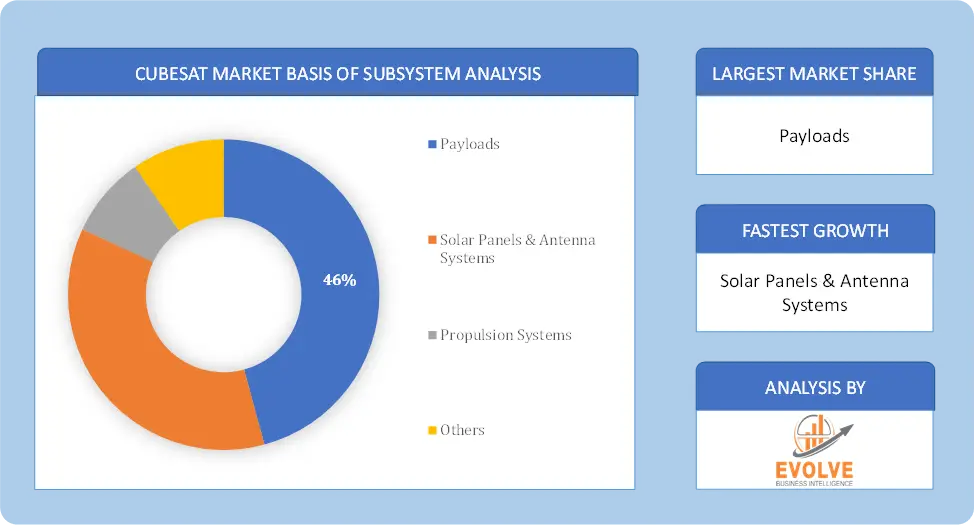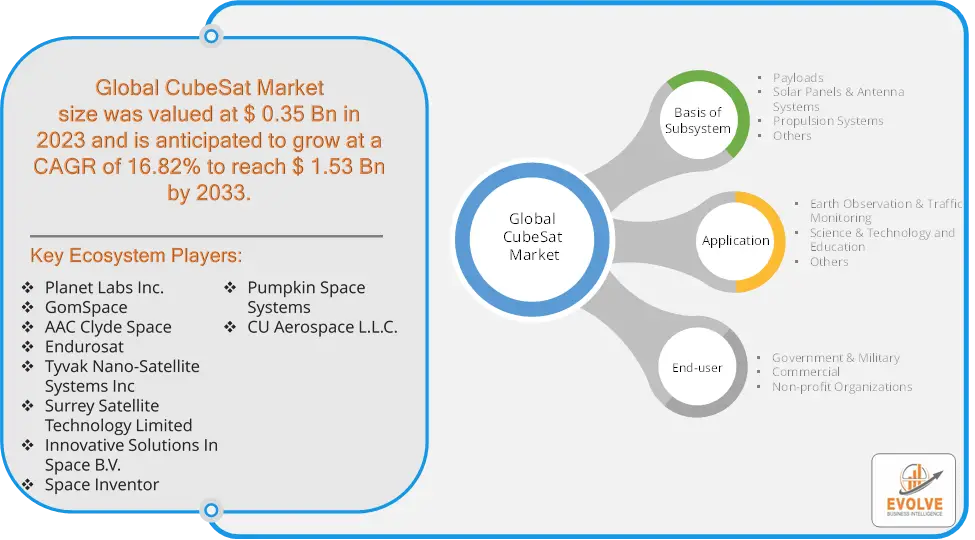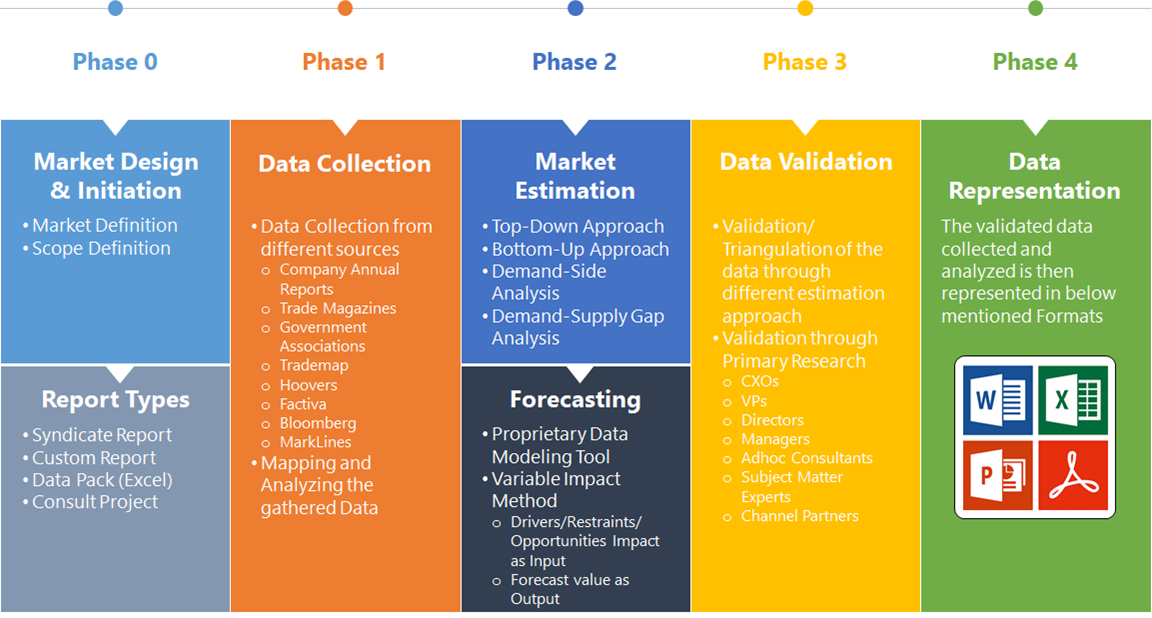CubeSat Market Overview
The CubeSat Market Size is expected to reach USD 1.53 Billion by 2033. The CubeSat Market industry size accounted for USD 0.35 Billion in 2023 and is expected to expand at a compound annual growth rate (CAGR) of 16.82% from 2023 to 2033. The CubeSat Market refers to the global industry related to the development, manufacturing, launch, and operation of CubeSats, which are a type of miniaturized satellite for space research and commercial applications. CubeSats are standardized, small, and lightweight, typically with dimensions of 10x10x10 cm per unit (U), and they can be scaled up to larger sizes (e.g., 2U, 3U, 6U, etc.). These satellites are used for various purposes, including scientific research, Earth observation, communication, technology demonstration, and educational projects.
The CubeSat Market is dynamic and evolving, with continuous innovation and increasing opportunities across various sectors and regions. The CubeSat market is expected to grow significantly, driven by technological advancements, declining costs, and expanding applications.
Global CubeSat Market Synopsis
The COVID-19 pandemic had a significant impact on the CubeSat Market. The pandemic caused delays in the production and delivery of essential components such as semiconductors, sensors, and other electronic parts. Restrictions on transportation and movement led to delays in the shipment of materials and finished products. Temporary closures of manufacturing facilities due to lockdowns and health regulations slowed down production schedules. Many CubeSat launch missions were delayed as launch providers adjusted their schedules in response to the pandemic. Project timelines were extended as teams adapted to remote work environments and faced delays in obtaining necessary components. The need for monitoring environmental changes and disaster management heightened the demand for Earth observation CubeSats. The pandemic highlighted the importance of flexibility and resilience, leading companies to adopt more adaptable project management and operational practices. Continued innovation in Earth observation and remote sensing technologies, driven by the need for real-time data during the pandemic.
CubeSat Market Dynamics
The major factors that have impacted the growth of CubeSat Market are as follows:
Drivers:
Ø Technological Advancements
Advances in miniaturization allow for sophisticated instruments and systems to be compacted into small satellite platforms without compromising performance. Enhanced capabilities in communication, propulsion, and onboard processing power make CubeSats increasingly viable for a range of complex missions. Universities and research institutions use CubeSats for educational purposes, providing hands-on experience in satellite design, engineering, and space science. CubeSats are increasingly used for scientific experiments and space research due to their cost-effectiveness and shorter development cycles.
Restraint:
- Perception of High Launch Costs and Space Debris
While CubeSats are cheaper to build, launch costs can still be significant, especially for dedicated missions. Limited availability of affordable launch options can be a barrier. The proliferation of small satellites, including CubeSats, contributes to the growing issue of space debris, increasing the risk of collisions and necessitating better debris management practices.
Opportunity:
- Constellation Development
Building networks of CubeSats for continuous monitoring and data collection. Processing and analyzing vast amounts of data from CubeSat constellations for valuable insights. Developing applications and services based on CubeSat constellation data. Opportunities to provide internet access in remote and underserved regions through CubeSat constellations. Supporting the growth of the Internet of Things (IoT) with low-latency communication for various applications such as smart cities and remote asset monitoring.
CubeSat Market Segment Overview
By Basis of Subsystem
 Based on Basis of Subsystem, the market is segmented based on Payloads, Solar Panels & Antenna Systems, Propulsion Systems and Others. The payload CubeSat dominant the market. CubeSats can complete the mission they were designed for because of their payloads. CubeSat payloads can include, among others, hyperspectral, multispectral, optical, and panchromatic cameras. Among the available CubeSat propulsion technologies, the electric propulsion systems (EPS) have developed as one of the up-and-coming technologies, with gridded ion thrusters and Hall-type being the most popular of such systems.
Based on Basis of Subsystem, the market is segmented based on Payloads, Solar Panels & Antenna Systems, Propulsion Systems and Others. The payload CubeSat dominant the market. CubeSats can complete the mission they were designed for because of their payloads. CubeSat payloads can include, among others, hyperspectral, multispectral, optical, and panchromatic cameras. Among the available CubeSat propulsion technologies, the electric propulsion systems (EPS) have developed as one of the up-and-coming technologies, with gridded ion thrusters and Hall-type being the most popular of such systems.
By Application
Based on Application, the market segment has been divided into Earth Observation & Traffic Monitoring, Science & Technology, and Education and Others. Earth observation and traffic monitoring is dominating the market. It is essential to conduct research concerning agriculture, geology, forests, and the environment to better understand the current living conditions on the planet and improve them. Over several years, various CubeSats systems outfitted with various spectral, radiometric, and spatial sensors were successfully launched to fulfill the requirements for Earth observation.
By End User
Based on End Users, the market segment has been divided into Government & Military, Commercial and Non-profit Organizations. CubeSat adoption in the commercial sector has increased significantly in recent years as the weight of satellite components has decreased, satellite components have become more standardized, and their costs have decreased. Agriculture, forestry, energy, media & entertainment, civil engineering, and archaeology use small satellites in this industry. Small satellites are utilized to obtain space-based Internet, high-resolution imagery of the Earth, and communication services.
Global CubeSat Market Regional Analysis
Based on region, the global CubeSat Market has been divided into North America, Europe, Asia-Pacific, the Middle East & Africa, and Latin America. North America is projected to dominate the use of the CubeSat Market followed by the Asia-Pacific and Europe regions.
 CubeSat North America Market
CubeSat North America Market
North America holds a dominant position in the CubeSat Market. It Dominates the CubeSat market with a substantial share. It has strong presence of aerospace and technology giants. Significant government and private investments in space exploration and mature CubeSat ecosystem with established launch providers, manufacturers, and ground stations.
CubeSat Asia-Pacific Market
The Asia-Pacific region has indeed emerged as the fastest-growing market for the CubeSat Market industry. Rapidly expanding market with significant growth potential. Increasing government support for space programs. Emerging CubeSat manufacturers and launch providers and large population and diverse applications driving demand.
Competitive Landscape
The global CubeSat Market is highly competitive, with numerous players offering a wide range of software solutions. The competitive landscape is characterized by the presence of established companies, as well as emerging startups and niche players. To increase their market position and attract a wide consumer base, the businesses are employing various strategies, such as product launches, and strategic alliances.
Prominent Players:
- Planet Labs Inc.
- GomSpace
- AAC Clyde Space
- Endurosat
- Tyvak Nano-Satellite Systems Inc
- Surrey Satellite Technology Limited
- Innovative Solutions In Space B.V.
- Space Inventor
- Pumpkin Space Systems
- CU Aerospace L.L.C.
Scope of the Report
Global CubeSat Market, by Basis of Subsystem
- Payloads
- Solar Panels & Antenna Systems
- Propulsion Systems
- Others
Global CubeSat Market, by Application
- Earth Observation & Traffic Monitoring
- Science & Technology and Education
- Others
Global CubeSat Market, by End User
- Government & Military
- Commercial
- Non-profit Organizations
Global CubeSat Market, by Region
- North America
- US
- Canada
- Mexico
- Europe
- UK
- Germany
- France
- Italy
- Spain
- Benelux
- Nordic
- Rest of Europe
- Asia Pacific
- China
- Japan
- South Korea
- Indonesia
- Austalia
- Malaysia
- India
- Rest of Asia Pacific
- South America
- Brazil
- Argentina
- Rest of South America
- Middle East & Africa
- Saudi Arabia
- UAE
- Egypt
- South Africa
- Rest of Middle East & Africa
| Parameters | Indicators |
|---|---|
| Market Size | 2033: $1.53 Billion |
| CAGR | 16.82% CAGR (2023-2033) |
| Base year | 2022 |
| Forecast Period | 2023-2033 |
| Historical Data | 2021 |
| Report Coverage | Revenue Forecast, Competitive Landscape, Growth Factors, and Trends |
| Key Segmentations | Basis of Subsystem, Application, End User |
| Geographies Covered | North America, Europe, Asia-Pacific, Latin America, Middle East, Africa |
| Key Vendors | Planet Labs Inc., GomSpace, AAC Clyde Space, Endurosat, Tyvak Nano-Satellite Systems Inc, Surrey Satellite Technology Limited, Innovative Solutions In Space B.V., Space Inventor, Pumpkin Space Systems and CU Aerospace L.L.C. |
| Key Market Opportunities | • Constellation Development • Communication and Connectivity |
| Key Market Drivers | • Technological Advancements • Rising Interest from Educational and Research Institutions |
REPORT CONTENT BRIEF:
- High-level analysis of the current and future CubeSat Market trends and opportunities
- Detailed analysis of current market drivers, restraining factors, and opportunities in the future
- CubeSat Market historical market size for the year 2021, and forecast from 2023 to 2033
- CubeSat Market share analysis at each product level
- Competitor analysis with detailed insight into its product segment, Government & Defense strength, and strategies adopted.
- Identifies key strategies adopted including product launches and developments, mergers and acquisitions, joint ventures, collaborations, and partnerships as well as funding taken and investment done, among others.
- To identify and understand the various factors involved in the global CubeSat Market affected by the pandemic
- To provide a detailed insight into the major companies operating in the market. The profiling will include the Government & Defense health of the company’s past 2-3 years with segmental and regional revenue breakup, product offering, recent developments, SWOT analysis, and key strategies.







